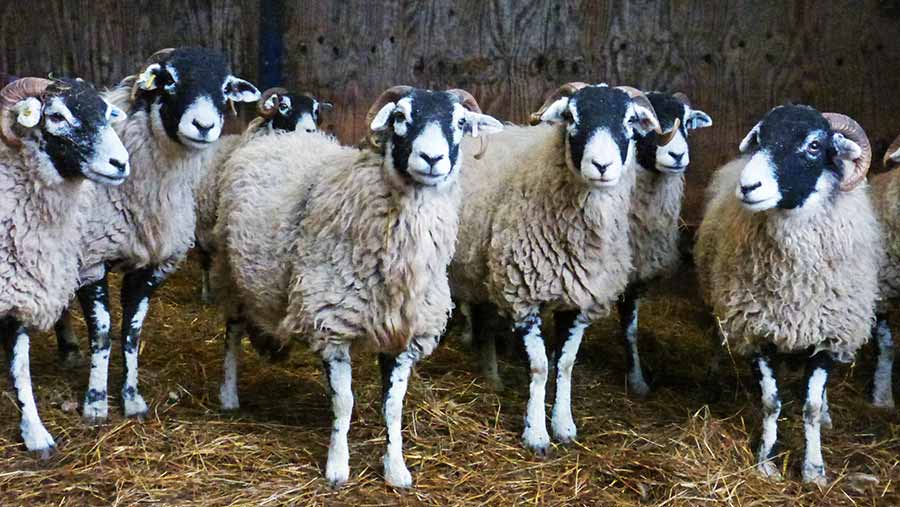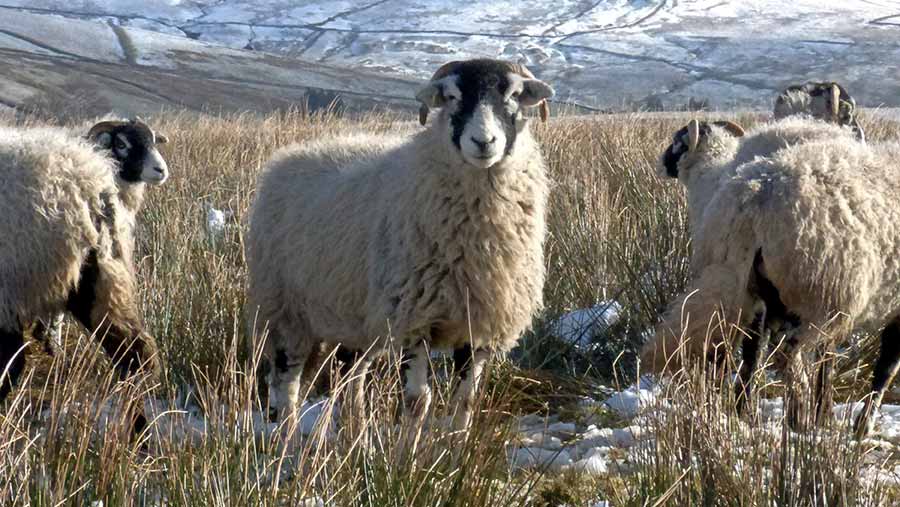Swaledale sheep breeder lifts output by a quarter
 © Michael Priestley
© Michael Priestley Lambing in a harsh climate and running ewes over nutritionally challenging moors has not stopped a Weardale family improving farm output by 25% in 12 years.
The Daltons of South Wellhope Farm, County Durham, have gradually increased scanning percentages 25-30% (now around 160% including Texdales, a Texel-sired Swaledale-cross for more conformation for store lamb/fat value).
They have also managed lamb mortality rates to produce an extra 150-180 lambs a year from their 650- to 700-head Swaledale flock.
“We’ve gradually seen production lift as we’ve made little adjustments around the farm,” says Greg, currently NFU Durham and North Riding vice-chairman.
See also: How Powys hill farmers are overcoming drop in support
One critical management change came back in 2004 when the Daltons began using a trace element drench after reporting geld rates around 1-2% higher and lambs with stiff legs dying.
Paul Keable of PK Nutrition diagnosed lead locking up copper, zinc, selenium and B vitamins.

Using a vitamin and trace element rench has improved geld and scanning rates
This is a common problem in the ex-lead mining Pennine areas as lead binds to proteins in the rumen otherwise used for absorption of other trace minerals.
“Lead tends to go where calcium is, getting stored in the bone and when a ewe lambs she uses calcium from bones to produce milk for the lamb, resulting in milk with elevated levels of lead which can lead to stiff lambs at three to four weeks old, although stiff lambs can be due to several issues, not just lead.”
The Daltons also support the drench with a free access mineral, prescribing 5ml with the first worm drench, 10ml at clipping and 10ml at weaning for lambs, with ewes requiring 15ml pre-tupping and 15ml mid-pregnancy.
“This has improved geld rates (number of empty sheep), which have probably dropped 1% and also improved lamb survival. If a lamb is weak on its legs it can’t travel with mother.”
Increasing productivity
- Retaining more gimmers from twins to raise scanning percentage
- Trace element drench addresses
- Constructing three sheds: Two 80×30 and one 60×30, allowing wethers to be finished and some hogs and all twins to be housed
- Plastic macs: Can save lambs but only used in very harsh weather. One lamb saved pays for two to three boxes
Higher scanning rates can mean little if the weather is bad in spring, admits Greg.
Lamb mortality can increase 5% or more in harsh springs but is generally around 12-15%.
Investing in lambing sheds has given the farm the confidence in having higher scanning results.
Plastic macs cost 16p/coat and spectam at 15-16p/dose are used to control environmental pressures outside and inside respectively.
See also: Ask the vet: your lambing questions answered
Lambs are weaned around 10 August at around 27kg, with the oldest being around 150 days. This is being achieved from 65kg ewes, although some wean their weight and are 55kg.
This year the farm managed 402 twins, 229 singles and 15 triplets with 27 geld, reflective of the farm’s typical 3-4% geld rate.
“We find tight skinned animals survive better on the hill, it tends to keep wind and water out,” explains Greg, who is happy scanning Texdales at around 170%.
“We are keeping more twins now and this helps breed twins which is traditionally not the strategy but with three new buildings in 12 years we have a bit of space to feed and lamb twin-bearing ewes.”
Lamb finishing
Historically South Wellhope sold 28kg weaned wether lambs as autumn stores, but increasing competition from continentals crosses forced a rethink in 2010.
Wethers are now moved to rented grazing for eight weeks post-weaning to finish, with some requiring a daily feed of 150-250g a head finishing ration of crushed barley and a 16%CP lamb pellet mixed 50:50 to get lambs up to 35-36kg.
“Selling a store lamb for £25 off a ewe barely pays for the mother’s wintering costs,” admits Greg, who is considering selling lambs through the Swaledale Sheep Breeders Association Marks and Spencer scheme. “This year we’ve been getting £55 to £60 for fat wethers.”
With grazing costs calculated at £10-£12 a head and winter housing and concentrate costs at another £10-£12 a head this means wethers being marketed at worth £30 more, boosting the gross margin by £15-£20 in some cases from 100 wethers last year.
Environmental value and Brexit
Environmentalists stress the in-bye and open moorland fringe areas that upland farms manage is of international significance for ground nesting birds.
This is a means of justifying substantial subsidy cheques that are vital for the farm’s survival, says father Dick.
South Wellhope farm facts
- 650-700 Swaledale ewes and 50 Texdales
- 35-40 Limousin-cross suckler herd
- Market 120 draft ewes, 60-70 shearlings and 60-100 gimmer lambs at St John’s Chapel
- Half way through High Level Stewardship scheme to run to 2022
- Farming 670ha (1,700 acres) of moorland
- Leasing 9ha (23 acres) summer grazing for cattle
“Without the upland supports we are dead as businesses,” he explains. Gross margins, calculated by Newcastle University as part of the Farm Business Survey, returned values of £4/livestock unit and £23/ha in 2012.
Greg sees the next five years as “challenging” but thinks hill farmers must explain the many landscape and environment-level benefits that hill farming brings to the public.
“Producing high quality food and breeding stock also underpins the rural economy,” he adds.
“Brexit has created short-term uncertainty. Domestically we need to educate the public to justify supporting upland farming using the public purse, like paying farmers on the results measured from environmental schemes.”
Such an initiative is taking place in Wensleydale at the moment.
Environmental restrictions at South Wellhope
- In a Higher Level Stewardship scheme since 2012
- Fertiliser restricted on pastures and forbidden on meadows
- No cutting before 20 July
- Meadows must be cleared by 22 May
- Common moor grazing numbers halved to 400 sheep
- Winter common grazing halved to 200 sheep
High Nature Value Farming: A brand for less productive areas
The High Nature Value (HNV) Farming concept official manifesto was launched in 2013 to recognise the environmental and cultural benefits of low intensity systems.
Support payments champion farms managing fragile ecosystems and notable cultural landscapes.
Upland farmer Richard Betton of the Upper Teesdale Agricultural Support Services (UTASS) says a “results based approach” may be required in his area in the future.
“Conservationists now recognise the need to conserve the resulting flora and fauna of many generations of farming in places such as the North Pennines.
“Our businesses are way off making a living from selling red meat but if we show the public goods and services we provide we can justify the supports we receive.”
Why are our moorlands and uplands important?
- Less than 900ha of meadows remain in the UK – 40% are found in the North Pennines
- Curlew, lapwing, snipe and redshank breed in upland grassland
- The Moorland Association states UK moors constitutes 75% of global moorland.
- More than 60% of SSIs are on moors managed for red grouse shooting. Black grouse is a protected “red status” species.
